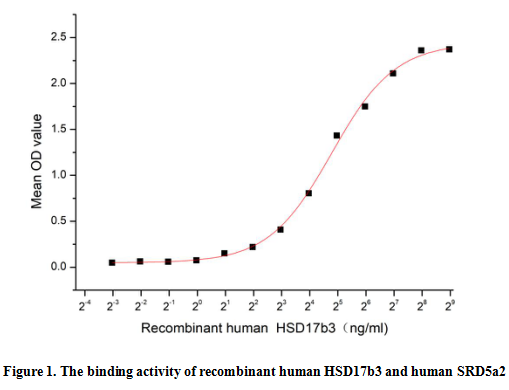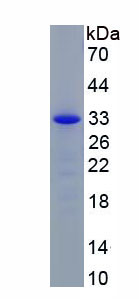Active 17-Beta-Hydroxysteroid Dehydrogenase Type 3 (HSD17b3) 

SDR12C2; EDH17B3; Short Chain Dehydrogenase/Reductase Family 12C,Member 2; Testosterone 17-Beta-Dehydrogenase 3; Testicular 17-beta-hydroxysteroid dehydrogenase
- UOM
- FOB US$ 266.00 US$ 666.00 US$ 1,332.00 US$ 3,996.00 US$ 9,990.00
- Quantity
Overview
Properties
- Product No.APF173Hu01
- Organism SpeciesHomo sapiens (Human) Same name, Different species.
- ApplicationsCell culture; Activity Assays.
Research use only - DownloadInstruction Manual
- CategoryEnzyme & Kinase
- Buffer FormulationPBS, pH7.4, containing 0.01% SKL, 5% Trehalose.
- Traits Freeze-dried powder, Purity > 90%
- Isoelectric Point8.9
Sign into your account
Share a new citation as an author
Upload your experimental result
Review

Contact us
Please fill in the blank.
Activity test

17-Beta-Hydroxysteroid Dehydrogenase Type 3 (HSD17b3) belongs to the HSD17B family with NAD(P)H/NAD(P) -dependent oxidoreductase activity that catalyzes the interconversion between 17-ketosteroids and 17-hydroxysteroids to maintain the balance between less potent (17-keto) and more potent (17β-hydroxy) forms of estrogens and androgens. This isoform of 17 beta-hydroxysteroid dehydrogenase is expressed predominantly in the testis and catalyzes the conversion of androstenedione to testosterone. 3-oxo-5-alpha-steroid 4-dehydrogenase 2 (SRD5a2 ) is a enzyme which plays a central role in sexual differentiation and androgen physiology. A functional ELISA assay was conducted to detect the interaction of recombinant human HSD17b3 and recombinant human SRD5a2. Briefly, HSD17b3 was diluted serially in PBS with 0.01% BSA (pH 7.4). Duplicate samples of 100 μl were then transferred to SRD5a2-coated microtiter wells and incubated for 1h at 37℃. Wells were washed with PBST and incubated for 1h with anti-HSD17b3 pAb, then aspirated and washed 3 times. After incubation with HRP labelled secondary antibody for 1h at 37℃, wells were aspirated and washed 5 times. With the addition of substrate solution, wells were incubated 15-25 minutes at 37℃. Finally, add 50 µL stop solution to the wells and read at 450/630nm immediately. The binding activity of recombinant human HSD17b3 and recombinant human SRD5a2 was shown in Figure 1, the EC50 for this effect is 27.6 ng/mL.
Usage
Reconstitute in 10mM PBS (pH7.4) to a concentration of 0.1-1.0 mg/mL. Do not vortex.
Storage
Avoid repeated freeze/thaw cycles. Store at 2-8°C for one month. Aliquot and store at -80°C for 12 months.
Stability
The thermal stability is described by the loss rate. The loss rate was determined by accelerated thermal degradation test, that is, incubate the protein at 37°C for 48h, and no obvious degradation and precipitation were observed. The loss rate is less than 5% within the expiration date under appropriate storage condition.
Increment services
-
 BCA Protein Quantification Kit
BCA Protein Quantification Kit
-
 Molecular Mass Marker for Protein
Molecular Mass Marker for Protein
-
 Monoclonal Antibody Customized Service
Monoclonal Antibody Customized Service
-
 Polyclonal Antibody Customized Service
Polyclonal Antibody Customized Service
-
 Protein Activity Test Experiment Service
Protein Activity Test Experiment Service
-
 Electrophoretic Mobility Shift Assay (EMSA) Experiment Service
Electrophoretic Mobility Shift Assay (EMSA) Experiment Service
-
 Buffer
Buffer
-
 Lentivirus Packaging Experiment Service
Lentivirus Packaging Experiment Service
-
 Adenovirus Packaging Experiment Service
Adenovirus Packaging Experiment Service
-
 Real Time PCR Experimental Service
Real Time PCR Experimental Service
-
 Spike RBD Protein (S-RBD)
Spike RBD Protein (S-RBD)
-
 Protein G
Protein G
-
 Protein A
Protein A
Citations
- Evaluation of 17β-hydroxysteroid Dehydrogenase Activity using Androgen Receptor-mediated TransactivationPubmed: 31614207
- Analyses of Molecular Characteristics and Enzymatic Activities of Ovine HSD17B334679897







